We may receive a commission when you use our affiliate links. However, this does not impact our recommendations.
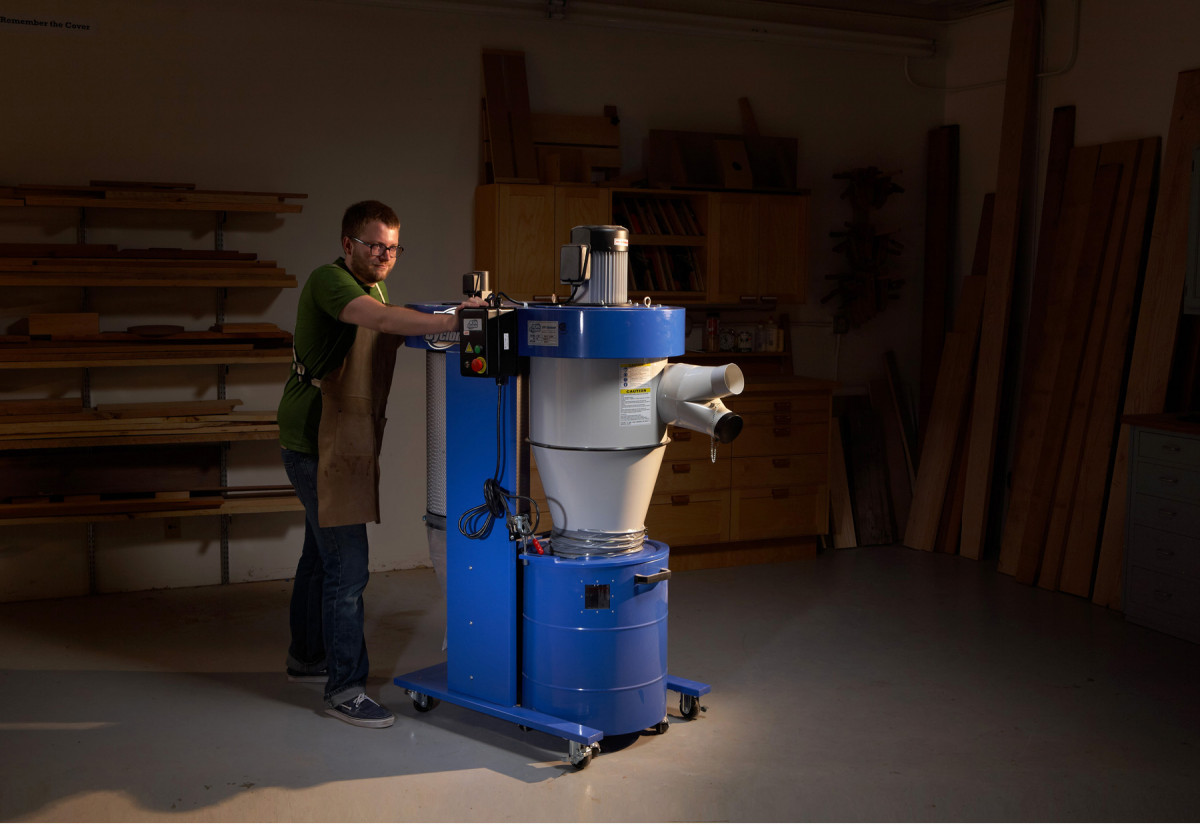
These advanced dust collectors are now more versatile than ever.
Dust collectors for the small shop have come a long way since the days of a broom and a pan. The latest generation—two-stage cyclones on casters—are more powerful, more efficient and quieter than any previous machines of a similar size.
There are at least six mobile cyclones on the market right now, and more are probably on the way. This is still a young, emerging field with plenty of competition. In this article, we’ll explain how cyclones work, compare the performance of the six machines, and give you a rundown on their features.
How a Cyclone Works
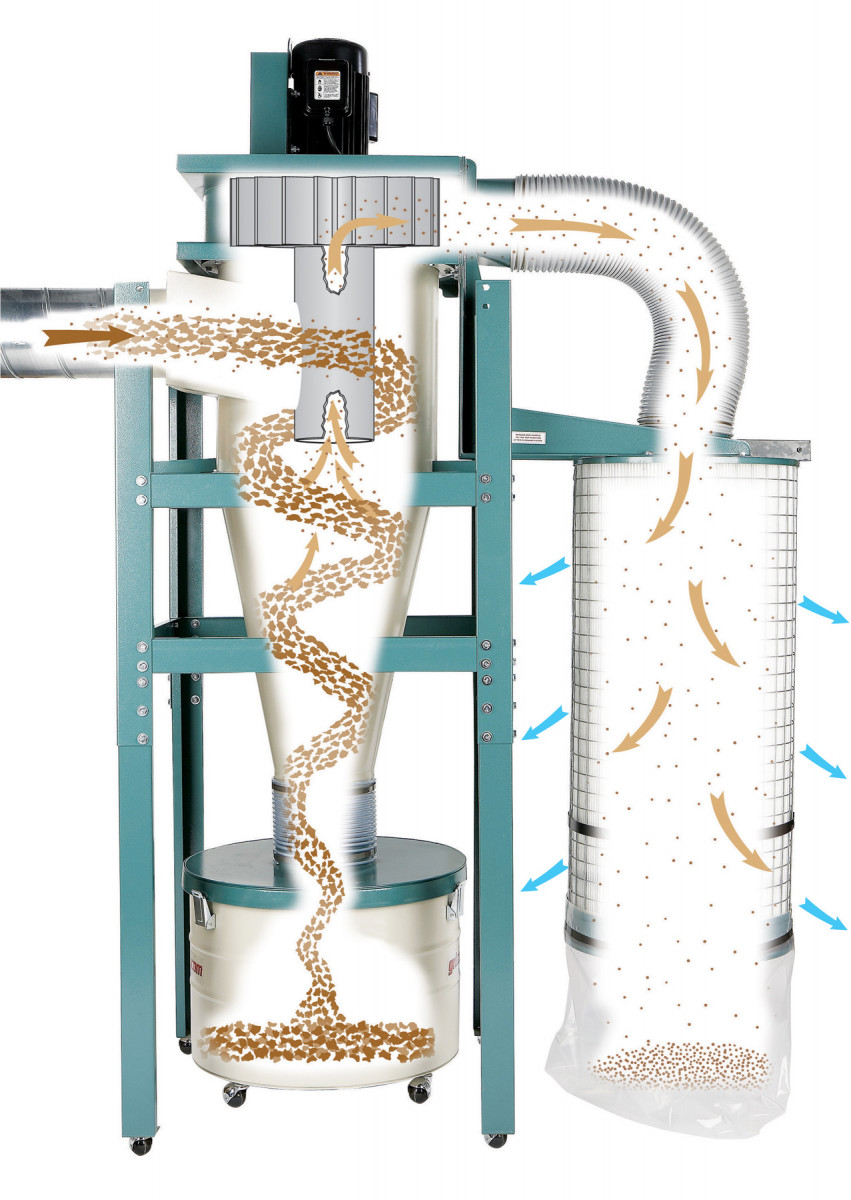 A cyclone is a two-stage dust collector. During the first stage, the collection stream enters the cyclone at the inlet and debris is flung to the outside of the separator, where it spirals down into the collection drum.
A cyclone is a two-stage dust collector. During the first stage, the collection stream enters the cyclone at the inlet and debris is flung to the outside of the separator, where it spirals down into the collection drum.
The fan-housing inlet tube begins the second stage. The tube hangs down in the middle of the cyclone body clear of the spiraling debris stream. The relatively clean air is pulled into the impeller, then pushed through the filter. The filter scrubs out the remaining fine particles.
2 Important Terms
CFM (Cubic Feet per Minute) is the volume of air that’s moving through a hose or duct. CFM is calculated using the speed of the air and the diameter of the duct it’s moving through. The higher the CFM, the more chips and dust the collector will collect.
Static Pressure can be thought of as the resistance of air moving through a duct or hose in a dust collection system. Friction from the wall of the duct slows down the air, and this slow-down is calculated as static pressure loss. Flex hose creates much more friction than smooth-walled duct, raising static pressure loss and lowering CFM. Bends and reductions in duct diameter also increase static pressure loss.
Benefits of a cyclone
There are two basic types of small-shop dust collectors: single-stage and two-stage. Single-stage machines have been on the market for quite a while, and you’re probably familiar with their two-bag look. In a single-stage collector, the dust stream goes directly through a large fan blade, called an impeller, and then into a collection bag. Fine particles are captured by a second bag—or a cartridge—acting as a filter. Single-stage collectors aren’t very complicated, so they generally are fairly inexpensive.
Cyclones are two-stage machines. They’re much more efficient than single-stage collectors, and have two significant advantages: Cyclones can generate higher CFM and overcome greater static pressure loss. (See How A Cyclone Works and 2 Important Terms, left.) In simple terms, they suck harder.
Early stationary cyclone models were quite large, often over 8′ tall—a non-starter for many small shops. They were designed to be the heart of a central dust collection system, with ductwork running far across a shop. Mobile cyclones are a new breed. They’re smaller (all are under 8′ tall) and lighter. They’re ideal for a garage shop, where large machines are placed on wheels so they can be stowed away. You can roll a mobile cyclone right to your jointer or planer, hook up a flex hose, and be in business in no time. All of the machines we tested would do well in this situation (see Test Results, page 49). To maximize CFM, the diameter of the hose should be as large as possible. As our test results show, using a 5″ hose instead of a 4″ hose boosts CFM by about 40%. In addition, the length of the hose should be kept to a minimum.
A mobile cyclone could be used for a small central system, too. If you have your tablesaw, jointer and planer in a cluster, for example, you could position a cyclone in the middle and collect from two or three machines using separate hoses. We put this proposition to the test with each machine. Three of the cyclones came with reducers that had two 4″ ports, so we set up all of the models with two 10′ long runs of 4″ hose, leaving open both runs. We found that this is not an ideal setup, however. It reduced CFM by about 1/3 at the machine, causing some cyclones to pull less than 400 CFM, the recommended minimum for most woodworking machines. For a cluster setup, we recommend that you install blast gates on both runs and keep only one gate open at a time.
Consider another situation: Your shop is small, but your machines aren’t grouped together. They’re spread out, and you’d like to connect them to a central collector with short runs of duct. Would one of these mobile cyclones work? The top-performing models will, we’re happy to report; but of course their effectiveness depends on how long your runs are, and how well the runs are designed (see Optimizing CFM, page 48).
Features
Power aside, a number of features can make one cyclone more user-friendly than another. (To compare machines, see the individual reviews on page 50.) These features are:
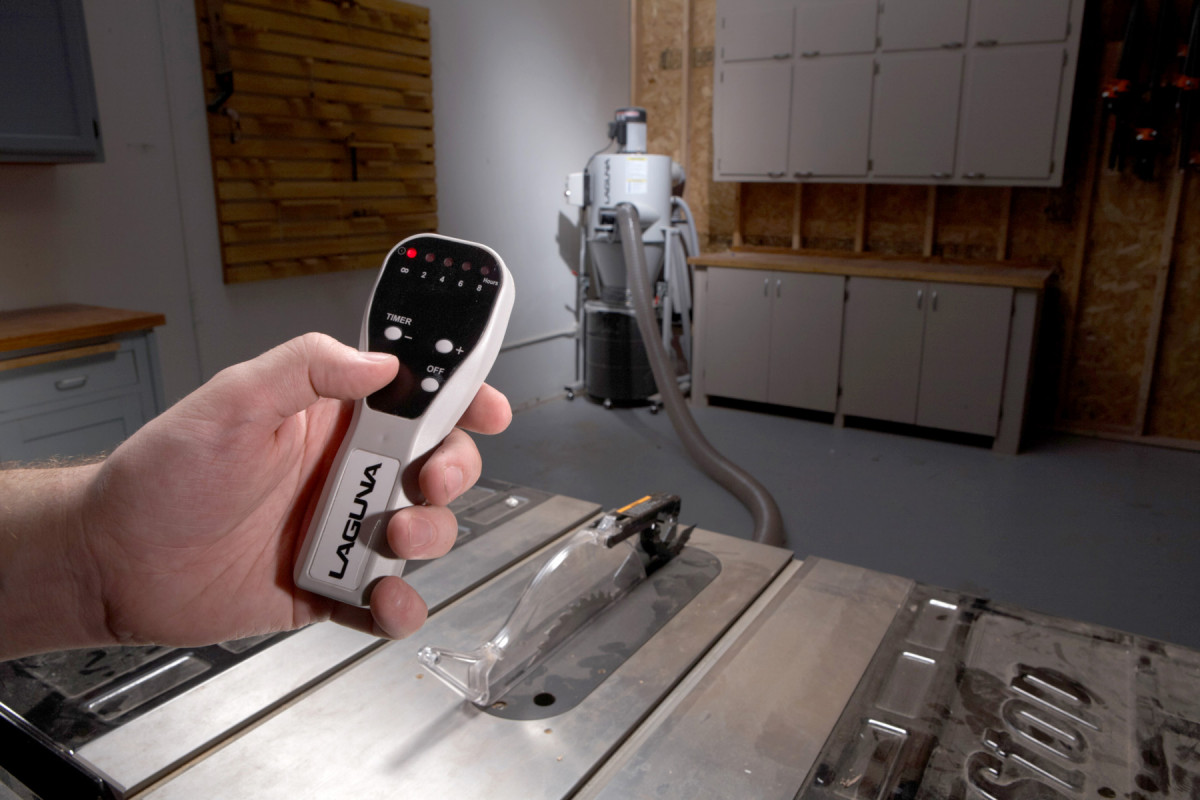
A remote control—standard equipment on some models—enables you to turn the cyclone on or off from wherever you’re working.
• Remote control. This device will turn your dust collector on and off from up to 30′ away or more, depending on the model. Some remotes are programmable to run the collector from one hour to eight hours or more. When you’ve got a remote, you’re more likely to turn on the collector, even for quick cuts. It’s a big plus.
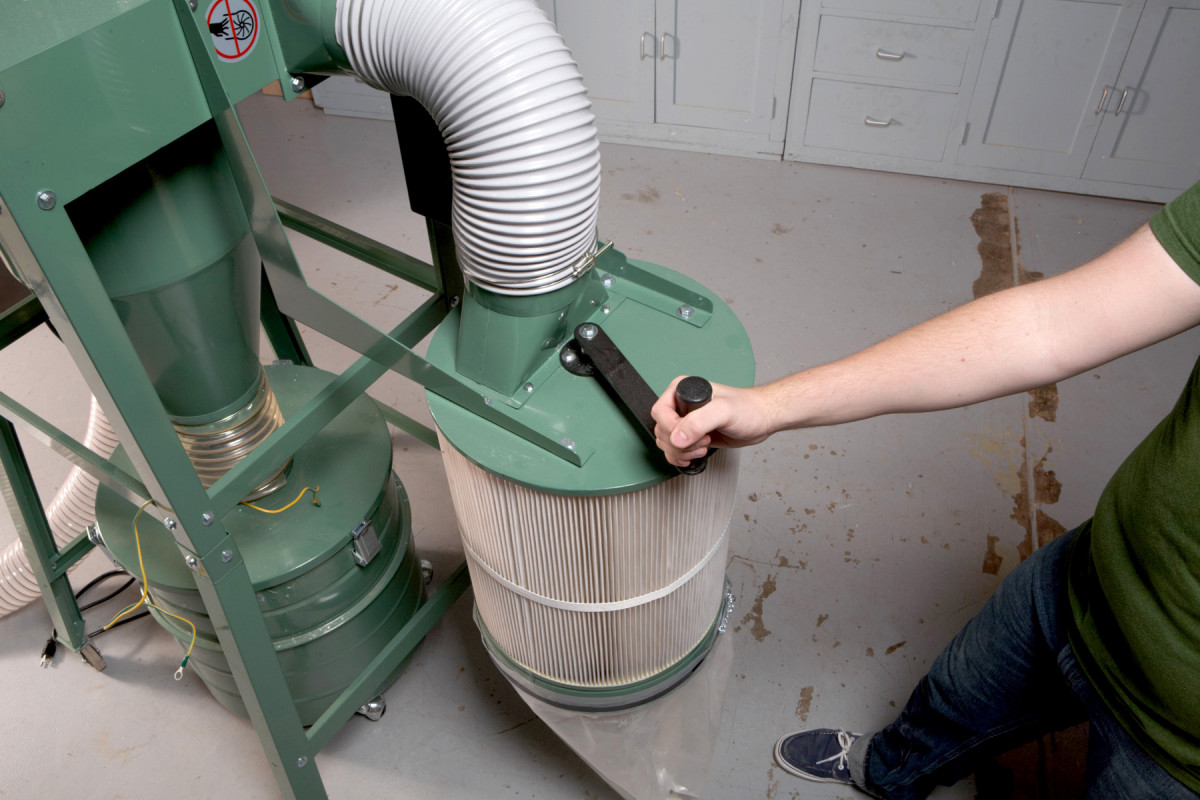
A mechanical agitator knocks dust off the inside of the filter. Keeping the filter clean maximizes airflow.
• Mechanical filter cleaning. A dust-clogged filter decreases airflow, so it’s important to keep it clean. Some machines have a handle above the filter that’s connected to a paddle inside. Rotating the handle knocks off most of the dust. Some experts contend that this cleaning isn’t adequate. They recommend that you blow out the filter, from the outside, with an air hose. If you don’t have a compressor, a mechanical cleaner is the next best thing.

Toggle clamps for detaching the barrel from the cyclone make it much easier to take out the trash.
• Easy emptying. All of the chips that you make by planing or jointing end up in a barrel underneath the cyclone. It’s essential to empty the barrel before it overfills. If you don’t, the chips will back up into the cyclone and eventually spill over into the filter. The filter then gets tightly packed with chips, airflow drops, and you’re faced with a huge, dusty cleanup job. All of this can be easily avoided if you visually monitor the level of the chips in the barrel and routinely empty it—or if your cyclone has an overfill sensor. However, some barrels are much easier to disconnect from the machine than others. With the awkward ones, you’re tempted to put off the chore and perhaps suffer the consequences. For that reason, we really like a barrel connection system that’s easy to use. The best design employs two toggle clamps that use the weight of the collector to seal the lid on the barrel.
• Small tool dust collection. Can you connect a cyclone to a router table or sander? If you’re using a small-diameter hose, the answer for most machines may be: Not really, because you won’t get adequate CFM. ( A small-diameter hose creates a great deal of static pressure loss.) One model, however, has electronic circuitry that improves CFM when using small-diameter hoses.
• Mobility. If you need to wheel a cyclone around the shop, note our comments on which models are easier to steer into tight quarters. The collection drums on most models have casters—a nice convenience.
• Inlet size. Bigger is better. A bigger inlet allows more air into the cyclone, making it easier for the motor and impeller to move air through the cyclone.
The bottom line
If you’re planning on rolling a cyclone up to a single machine, all six models we tested will do fine under optimum conditions.
You can also hook up a mobile cyclone to longer runs of duct or flex hose, but there are clear differences in performance among the models.
Once you’ve figured out which model is powerful enough for your situation, check out its other features.
2 New Features
One of the machines we tested, the Oneida Smart Dust Collector, has two features that break new ground in cyclone design.
 An overfill sensor lights up when the barrel is full. Overfilling a barrel is bad news—the extra chips may jam up the cyclone’s filter and drastically reduce airflow. Some barrels have viewing windows for monitoring the level of chips inside, but a light is more convenient.
An overfill sensor lights up when the barrel is full. Overfilling a barrel is bad news—the extra chips may jam up the cyclone’s filter and drastically reduce airflow. Some barrels have viewing windows for monitoring the level of chips inside, but a light is more convenient.
 Electronic feedback makes a cyclone more versatile. The Smart Dust Collector has electronic circuits that adjust the speed of the impeller according to the amount of resistance the machine senses. In practical terms, this means higher CFM and 2-3 times the suction (static pressure) when you connect a small-diameter hose to your router table or sander.
Electronic feedback makes a cyclone more versatile. The Smart Dust Collector has electronic circuits that adjust the speed of the impeller according to the amount of resistance the machine senses. In practical terms, this means higher CFM and 2-3 times the suction (static pressure) when you connect a small-diameter hose to your router table or sander.
Optimizing Your System

Here are some guidelines to improve the efficiency of your dust collection system:
• Use as little flex hose as necessary. Use as large a diameter as feasible.
• Increase the size of a machine’s dustport, if possible.
• Locate your dust collector near your machines, to minimize the necessary length of duct or hose.
• Use gradual curves, not right-angle bends, for hoses or duct.
• Use smooth-walled metal duct for long runs. At the inlet, the duct should be the largest diameter your dust collector will accept.
• If you’re connecting your cyclone to multiple machines with more than one hose, put the cyclone nearest to the machine that creates the most dust and chips. Install blast gates on each run.
Test Results

Some cyclones are clearly more powerful than others, regardless of their horsepower. We’ve measured the CFM each machine delivers in four hypothetical situations. The minimum suggested CFM numbers are widely used industry standards.
• 2″ Flex Hose. You’d use this hose to connect to a router table, combo disc/belt sander, or a benchtop tool. Our test hose was 10′ long.
• 4″ Flex Hose. Most dustports and hoses are 4″ dia. We ran our tests using a 10′ long hose. Shortening the hose will increase CFM—somewhat. We found that reducing the length of the hose to from 10′ to 6′ only increases CFM by an average of 6%.
• 5″ Flex Hose. All of the collectors can accommodate a 5″ hose; we used one that was 10′ long. The dustports on some machines are 5″ dia., or can be enlarged to 5″ dia. We found that increasing the diameter of a 10′ long hose from 4″ to 5″ raises CFM by an average of 40%.
• Central system. We built a 40′ long central system with smooth-walled duct. It began with 6″ duct at each cyclone’s inlet (5″ duct for the General International cyclone, which has a 5″ inlet). The line was stepped down in diameter at three drops (5″, 4″ and 4″) spaced at 10′ intervals. We installed gates and 5′ of flex hose at the end of each drop. We’ve reported CFM as a range. At the top of the range, the first gate (5″) is open and the other two are closed; at the bottom of the range, the third gate (4″) is open and the first two are closed.
General International 10-800CF M1
 $1,199
$1,199
This 1-1/2 hp cyclone runs on a standard household 110V, 15-amp circuit, which makes it a good choice if your shop doesn’t have 220V service. It’s less powerful than the other 220V units we tested, but still capable of achieving recommended CFMs for most machines, if you use a 5″ hose. The collection drum has casters.
Remote Control Y
Mechanical Filter Agitator Y
Bucket Toggle Clamps N
Overfill Sensor N
Electronic Feedback N
Motor 1-1/2 hp, 110V
Inlet 5″, split into two 4″ ports
Drum 30 gal., with casters
Noise level 80 dB
Pros
• Runs on 110V.
Cons
• Relatively high noise level
• Less powerful than 220V models.
Contact
General International, www.general.ca, (888) 949-1161.
Grizzly GC703
 $928 with 220V switch; $850 with 110V switch
$928 with 220V switch; $850 with 110V switch
We tested this model running at 220V. Equipped with four rotating casters, Grizzly’s cyclone is particularly easy to maneuver. You can also use a removable plastic bag inside the drum to make emptying easier. A suction hose inside the barrel holds the bag taut. The collection drum has casters. This model’s 1-1/2 hp motor comes from the factory wired for 110V. You must use 5″ or smaller duct for a 20-amp 110V circuit; you can use 6″ duct on a 30-amp 110V circuit.
Remote Control Y
Mechanical Filter Agitator Y
Bucket Toggle Clamps N
Overfill Sensor N
Electronic Feedback N
Motor 1-1/2 hp, 110V or 220V
Inlet 6″ or 5” with reducer
Drum 30 gal., with casters
Noise level 65 dB
Pros
• Lowest noise level.
• Collection barrel accepts plastic liners.
Cons
• Duct is limited to 5″ on 20-amp, 110V circuit, making CFM lower.
Contact
Grizzly Industrial, www.grizzly.com, (800) 523-4777.
JDS 2100-CKV
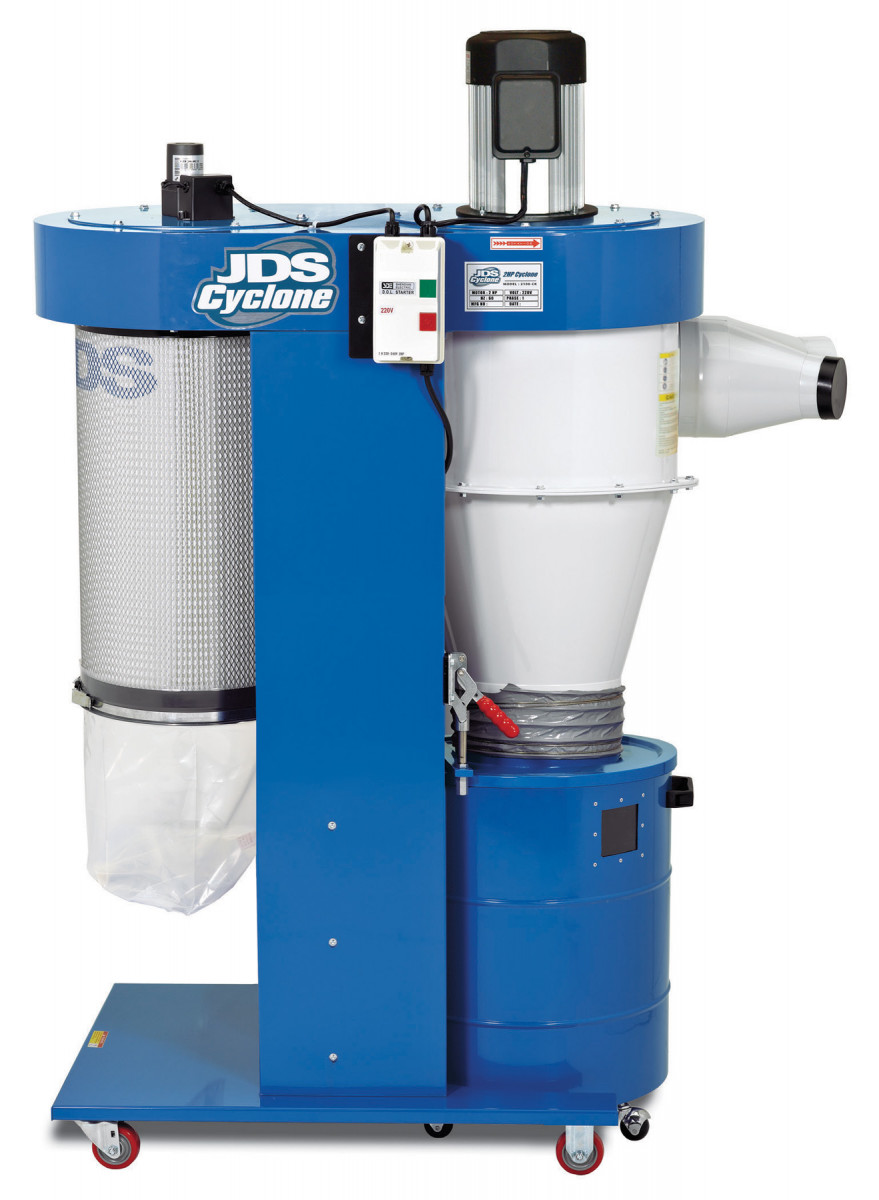 $1,299
$1,299
This cyclone is a powerful, compact machine with a big 8″ inlet. The inlet is stepped down to two 4″ ports, but you can maximize CFM by removing the reducer and running 6″ or 8″ duct or hose directly to the machine (we reduced the inlet to 6″ for our tests). This is the only model we tested with an automatic filter agitator that operates each time you turn off the machine, maximizing airflow by keeping dust build-up in the filter to a minimum. The collection drum has a window for checking how full it’s getting. A 3 hp version (3100-CK, $1,799) is also available.
Remote Control N
Mechanical Filter Agitator Y
Bucket Toggle Clamps Y
Overfill Sensor N
Electronic Feedback N
Motor 2 hp, 220V
Inlet 8″, reduced to two 4″ ports
Drum 35 gal., with casters
Noise level 74 dB
Pros
• 8″ inlet.
• Automatic filter agitator.
Cons
• With only two pivoting casters, it’s awkward to move.
• A remote isn’t included (available as an accessory for $89).
Contact
JDS Company, www.jdstools.com, (800) 480-7269.
Laguna MDC0560-0145
 $1,245
$1,245
This is the only model we tested that has all three basic convenience features. It’s very compact and is easy to move around. It’s the shortest unit, standing only 61″ high. The collection barrel has a window for viewing the level of the chips inside, and it uses a toggle-clamp connection system for easy emptying. A small-diameter hose connected to the cyclone provides suction to hold a barrel collection bag in place. The collection drum has casters. A 3 hp version (MDC3560-0145, $1,545) is also available.
Remote Control Y
Mechanical Filter Agitator Y
Bucket Toggle Clamps Y
Overfill Sensor N
Electronic Feedback N
Motor 2 hp, 220V
Inlet 6″, reduced to two 4″ ports
Drum 29 gal., with casters
Noise level 74 dB
Pros
• Easy to maneuver.
• Collection barrel accepts plastic liners.
Cons
• The agitator handle is at knee level.
Contact
Laguna, www.lagunatools.com, (800) 234-1976.
Oneida 2 hp Smart Dust Collector
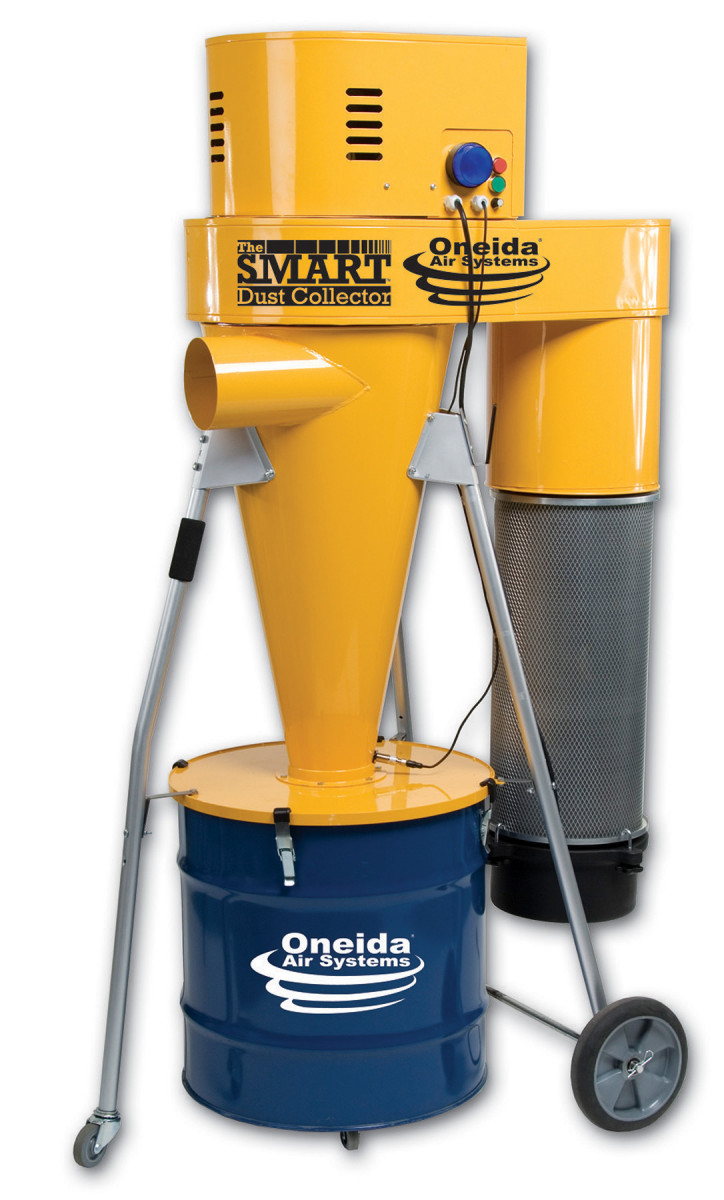 $1,987
$1,987
This is the only model we tested with electronics that adjusts the speed of the impeller to overcome the higher static pressures created by a long run or a small-diameter hose. It is also the only machine in the test that has a brand-name motor—Baldor—with a proven track record of reliability. The collection drum rides 1/2″ off the ground when connected to the cyclone. When you detach the clamps, the drum lowers onto its casters for easy removal. A 3 hp model (XXS030100, $2,360) is also available.
Remote Control Y
Mechanical Filter Agitator N
Bucket Toggle Clamps Y
Overfill Sensor Y
Electronic Feedback Y
Motor 2 hp, 220V
Inlet 6″
Drum 35 gal., with casters
Noise level 80 dB
Pros
• HEPA filter certified by G.E. to capture 99% of dust .3 – .5 microns.
• Has flame guard arrestor for fire safety.
Cons
• Relatively high noise level.
Contact
Oneida, www.oneida-air.com, (800) 732-4065.
Penn State TEMP2PCX
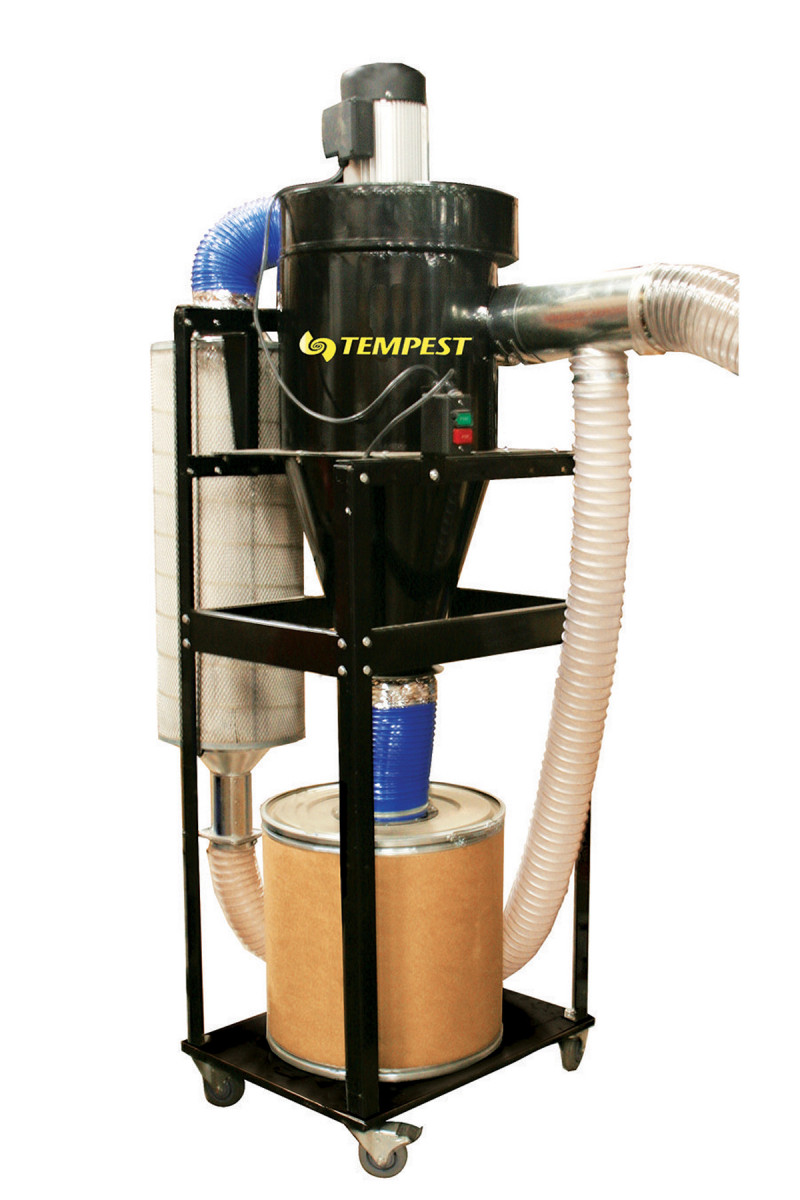 $895
$895
This is a high-performing, bare-bones cyclone at a relatively low price. It does have one unique feature: a hose and blast gate for emptying debris from the filter canister. This is much easier to use than a bag or canister under the filter. At 84″ high, this model is by far the tallest we tested. It may be too high for shops with doorways or low ceilings. The cardboard collection drum does not have casters.
Remote Control N
Mechanical Filter Agitator N
Bucket Toggle Clamps N
Overfill Sensor N
Electronic Feedback N
Motor 2 hp, 220V
Inlet 6″
Drum 35 gal., no casters
Noise level 76 dB
Pros
• Blast gate and hose to empty filter debris.
Cons
• 84″ tall.
Contact
Penn State Industries, www.pennstateind.com, (800) 377-7297.
Here are some supplies and tools we find essential in our everyday work around the shop. We may receive a commission from sales referred by our links; however, we have carefully selected these products for their usefulness and quality.






![Tooley Park Scriber Review [Discount Week of Feb 3 2025]](https://dev.popularwoodworking.com/wp-content/uploads/bfi_thumb/dummy-transparent-olcy6s63it1p9yp7uhusjas7c8kahafrhg9su7q9i0.png)

